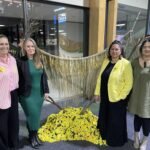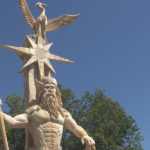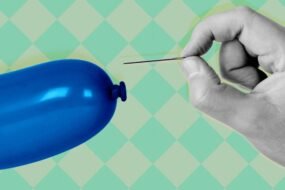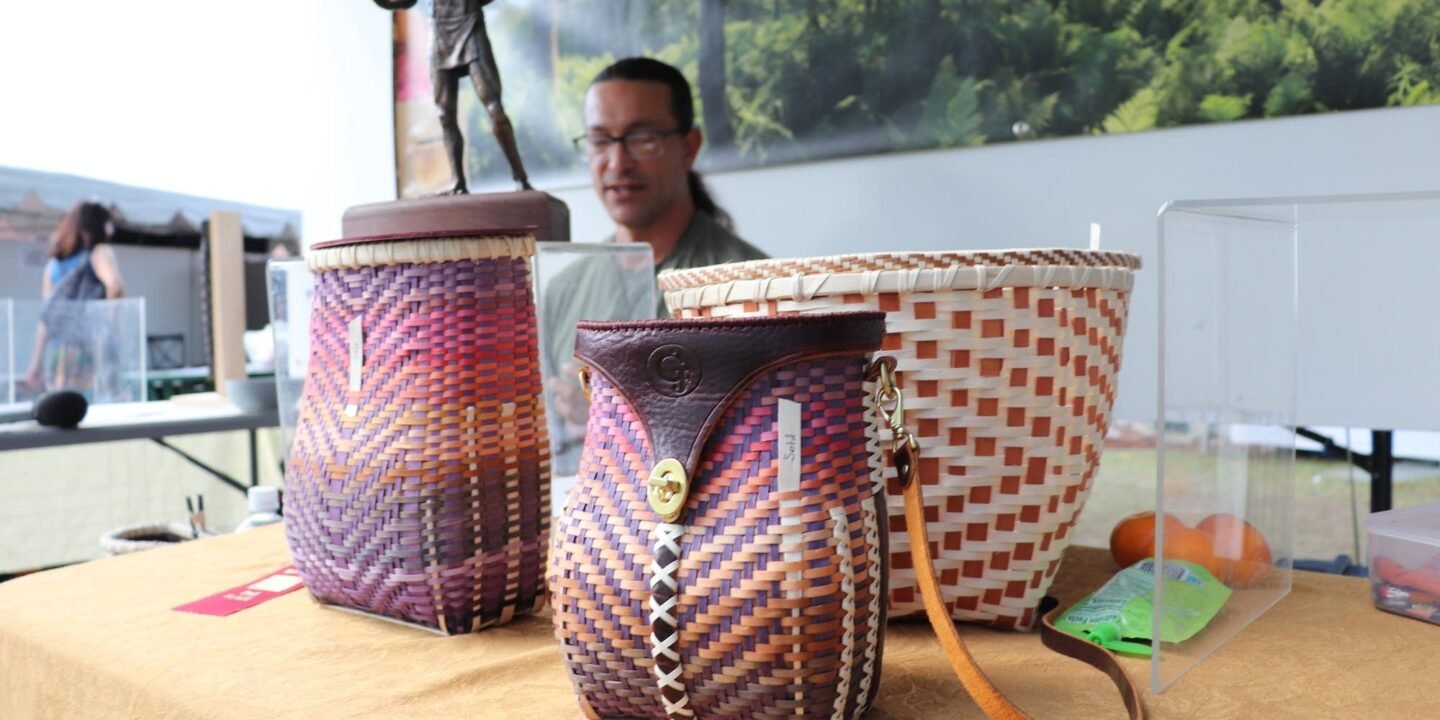
The Santa Fe Indian Market bills itself as the largest and most prestigious Native art market in the world. Most of its more than 1,000 exhibitors come with a variety of inventory. But Hunkpapa Lakota beadworker Beverly Bear King Moran had just a single piece for sale at her booth on Santa Fe’s historic plaza.
“This is a traditional Lakota horse mask,” Bear King Moran said. “It was inspired by our horse dance ceremonies and our men and women riders.”
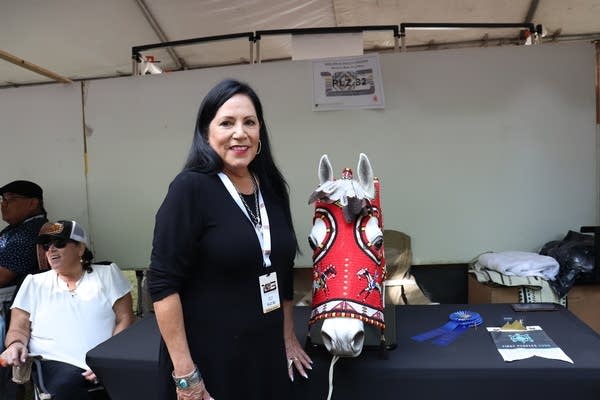
Beverly Bear King Moran stands with her horse mask, adorned with 300,000 beads. She values the mask at $47,000.
Savannah Peters/Marketplace
The mask is fully beaded and meant to adorn some very spoiled horse. It took Bear King Moran nine months of full-time beading to finish it. When she prices this piece, she’s essentially setting her annual salary.
“And it’s not a very good salary,” Bear King Moran said with a laugh.
Bear King Moran is an award-winning artist with 25 years under her belt. She tries to pay herself at least minimum wage plus the cost of materials.
“It’s beaded with size 13 Charlotte cut beads. It took 98 hanks to complete the piece. So there’s actually 300,000 beads on this mask,” Bear King Moran said.
She values the mask at $47,000, though it might ultimately sell for less. “People don’t always understand beadwork and why it’s so expensive,” she said.
Pricing and marketing beadwork is about to get harder. All 300,000 of those beads sewn onto the horse mask are imported from European Union countries like Italy. Bear King Moran purchased materials for the piece long before President Donald Trump’s tariffs took effect and said she can work from her existing bead library on small projects. But she expects her next large order to be pricey.
“Finding beads is getting harder, and you’re going to be paying more for them,” Bear King Moran said. “That’s a concern right now for every beadworker.”
At Indian Market, the artists’ work is rooted in their Indigenous traditions and homelands on the North American continent. But many work with materials sourced from around the world, exposing them to shifting trade policy.
Bear King Moran expects to have to raise the price of her next big piece, which could make it tougher to find a buyer. She’ll likely also have to accept a thinner profit margin.
Other artists work on a shorter timeline and don’t have the same buffer. That includes Choctaw seamstress Yasmine Del Rosario, who makes jewelry and contemporary clothes with what she calls culturally appreciative elements. At Indian Market, she shared a booth with her two sisters and displayed an orange, mid-calf skirt with satin ribbon sewn in a herringbone weave.
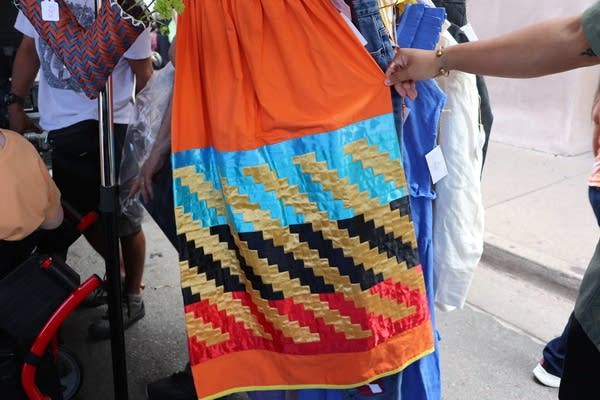
Yasmine Del Rosario’s orange skirt, woven just like a basket.
Savannah Peters/Marketplace
“I have the long strips [of ribbon], and I weave it just like a basket. Then, I have to sew each individual side of the ribbon,” Del Rosario said. “It took an immense amount of time.”
She’s hoping the skirt will sell for $400, in part to account for the surging cost of imported textiles.
“That’s making a lot of our garments more expensive, and people are kind of surprised by that,” she said. “We want to use quality, but fabric orders are getting more expensive than we anticipated.”
Del Rosario worried about staying competitive with other booths where artists might have been selling from a pre-trade war stash of materials or finding other ways to blunt the effect of tariffs, like selling on slimmer margins or localizing their supply chains.
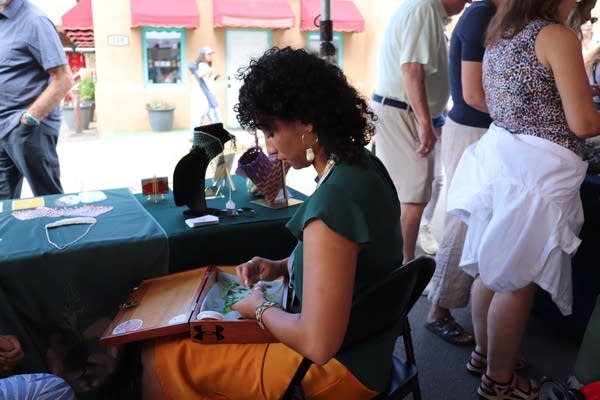
Yasmine Del Rosario sits and beads at her booth at the Santa Fe Indian Market.
Savannah Peters/Marketplace
“I just need seven mountain goats a year. That’s all, guys,” said Chilkat weaver Lily Hope, who is working to replace the merino wool she imports from New Zealand.
Hope put out a call to hunters and hikers in her southeast Alaskan community to help her harvest mountain goat hair, the traditional Chilkat weaving material.
“It’s been at least 100 years since a Chilkat blanket has been made of mountain goat hair, and there will be one, starting in January,” Hope said. “After I spend the next few months processing mountain goat.”
What Hope saves in import fees she will make up for in labor. She guesses it takes about 45 hours to remove the sticks and leaves from a mountain goat hide and process it into wool that can be used to spin yarn.

A pair of earrings made by Chilkat weaver Lily Hope.
Savannah Peters/Marketplace
“But moving toward that sovereignty of having my materials an arm’s reach away, instead of having to continue to utilize the world market, I think that’s going to be pretty powerful for my work going forward,” Hope said.
Passamaquoddy artist Gabriel Frey weaves baskets from black ash sourced from “the woods” and is very much insulated from tariffs on the supply side. Still, Frey worried about customers’ appetite for spending ahead of this year’s market.
“There was a lot of anxiety going into this show,” Frey said. “I don’t have a business if the people who are buying the art are affected to the point of not wanting to buy art.”
But Indian Market was as busy as Frey has seen it in his 10 years exhibiting. Collectors surprised him by basically buying him out of his baskets, which are priced in the thousands, in less than a day.
“I’ve had multiple people come up today who have said, ‘I’ve been wanting to do this for a long time and I’m gonna do it,’” Frey said “There very well may be that sort of like, ‘The Titanic is sinking, let’s just play the band.’”
Frey said something was in the air. In these uncertain times, people wanted to take home something beautiful.


